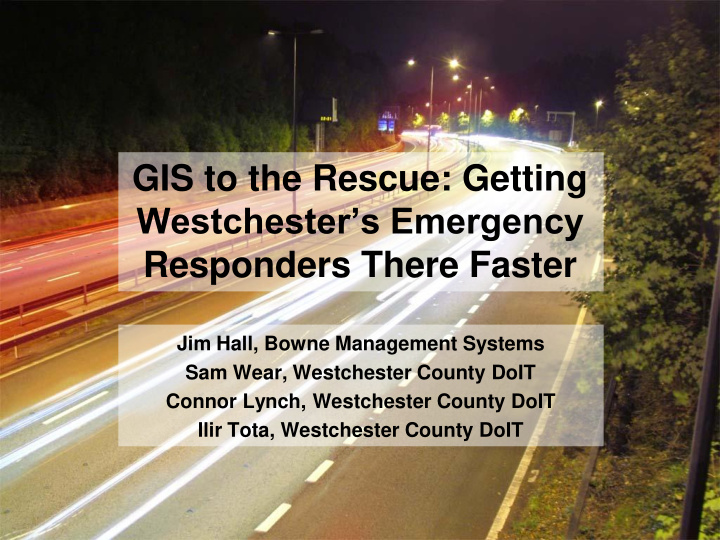



GIS to the Rescue: Getting Westchester’s Emergency Responders There Faster Jim Hall, Bowne Management Systems Sam Wear, Westchester County DoIT Connor Lynch, Westchester County DoIT Ilir Tota, Westchester County DoIT
Agenda 1. The Background & the Need 2. The Solution 3. The Project 4. Current Status 5. Looking Ahead
Background • Westchester County government maintained several street and address datasets: – Department of Emergency Services’ (DES) CAD streets dataset – Department of Information Technology’s ( DoIT) street centerline and address points
The Need • DES’ Intergraph system dispatches for Fire & EMS • The DES street data was a Navteq cut from 10+ years ago • The DoIT street data was current Navteq
Project Goals 1. Improve quality and completeness of the geographic data made available to DES 2. Eliminate redundant data entry
2. The Solution • Reconcile geometry: – DES street centerlines – DoIT street centerlines • Align geometry to basemap • Analyze and fix attribution • Align geometry to ESZ boundaries • Validate with incident data
3. The Project • DoIT and DES defined the scope • A competitive procurement was completed • Bowne Management Systems was selected to work with the County to complete the project
Bowne Management Systems • Based in NYC area • GIS/IT consulting and implementation firm • Founded in 1982 • Staff of approximately 40 professional staff • We have worked with Westchester County government since 2004 • Sister company is RouteSmart
Goal: Create Best Available Dataset • Completeness • Absolute horizontal positional accuracy • Topology • Address ranges • Street names and types • Alias street names and types • Municipalities • Traffic direction
The Realities of the Data • Strengths of the CAD data: – Address ranges – Address/ESZ relationship • Strengths of the GIS data: – Horizontal positional accuracy – Ability to update, analyze, manage and move the data
Based on Common Points • Operator picks some pairs • System suggests others • Operator validates & adjusts • Operator runs process • Operator QCs results
Issues Worked Through • Overlapping address ranges • Address range gaps • Scrambled ranges • Mixed parity • Directionality • Logical vs. actual ranges • Non-numeric addresses
“Normal” Addressing 12 14 16 6 18 20 4 2 22 9 11 13 7 5 17 3 19 21
Overlapping Address Ranges 12 14 16 6 18 20 4 2 22 9 11 13 7 5 17 3 19 21
Address Range Gaps 12 14 16 6 18 20 4 2 22 9 11 13 7 5 17 3 19 21
Scrambled Addresses 12 10 16 14 18 20 4 2 22 9 11 13 7 5 17 3 19 21
Mixed Parity (odd/even) 12 14 16 7 18 20 4 2 22 9 11 13 6 5 17 3 19 21
Directionality 12 14 16 6 18 20 4 2 22 9 11 13 7 5 17 3 19 21
Logical vs. Actual Ranges 12 14 16 6 18 20 4 2 22 9 11 13 7 5 17 3 19 21 Where’s 8 -10?
Non-numeric & Non-integer Addresses 12 14 14A 6 18 20 4 2 22 9 11 11½ 7 5 17 3 19 21
Segment Breaks • Address issues • ESZ boundaries • Street name/type issues • Directionality changes • Attribute changes
Re-aligning ESZ Boundaries
More Details, Details … • e.g. Limited access highways & ESZ boundaries
Validated with Real Incident Data • Used 25,000+ records • Checked ESZ returned • Investigated errors • Modified GIS data Repeated until no errors were found …
4. Current Status • System went live with GIS- maintained data in June 2013 • Updating by GIS specialists with ArcGIS and GeoMedia • The CAD data is re-loaded periodically via a “map roll” • Other GIS layers and new cartography have been added to the CAD
Maintenance - Sources • Municipalities • Public safety agencies • Photogrammetry Street geometries
Maintenance Workflow • County GIS updates the data once • The single definitive dataset is published to: – County’s enterprise geodatabase – DES’ CAD system (via extract) – County’s GIS websites – County’s Web Map services
5. Looking Ahead • Prepare to support dispatching for Police with same data • Prepare for Enhanced 9-1-1: – Address points – EGS integration – Cell phones • Other: – Reverse geocoding
GIS to the Rescue: Getting Westchester’s Emergency Responders There Faster Questions? Thank you.
Recommend
More recommend